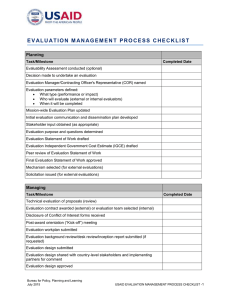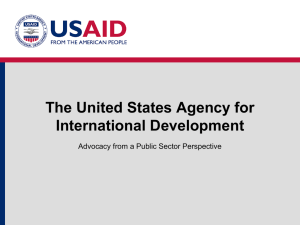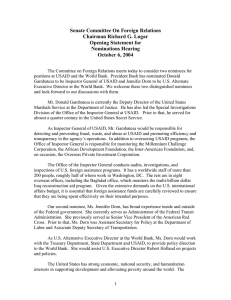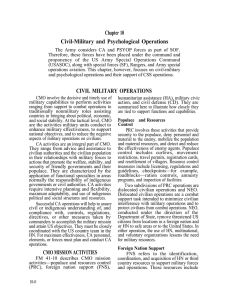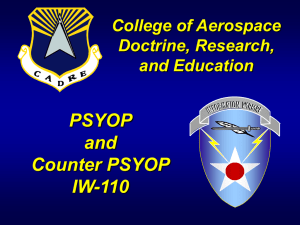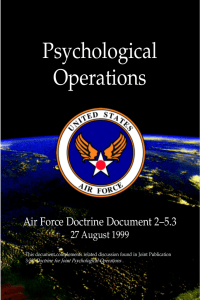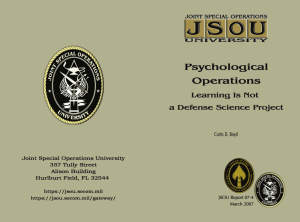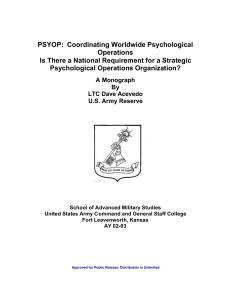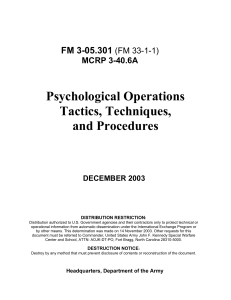Coordination and Support in Chapter 14
advertisement
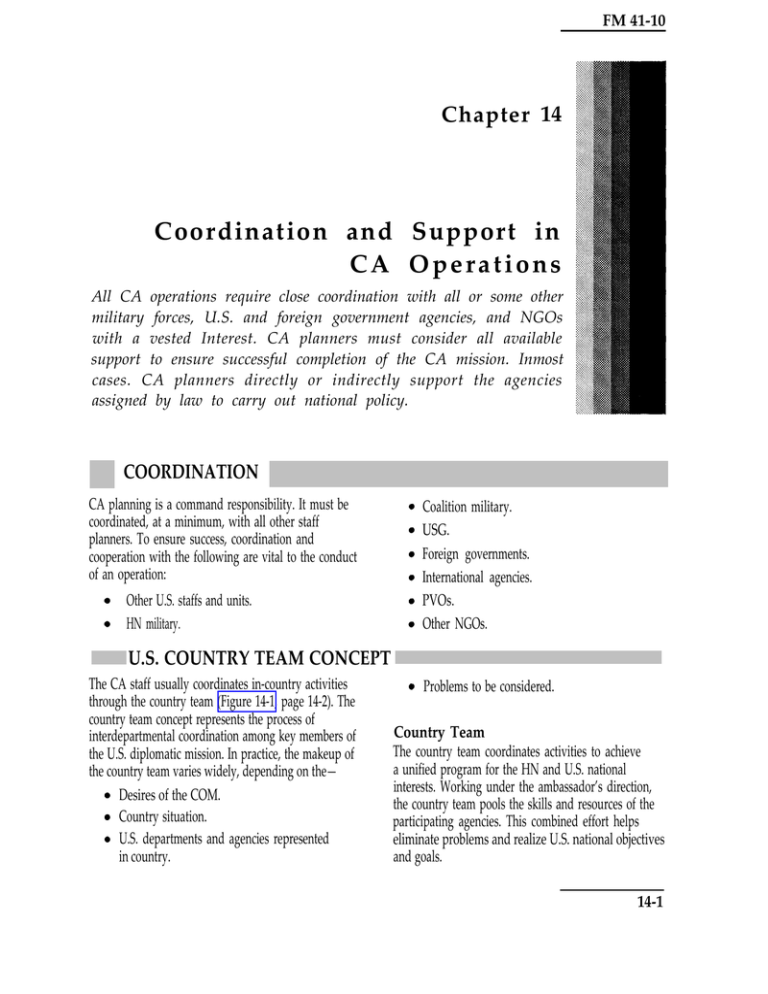
FM 41-10 Chapter 14 Coordination and Support in CA Operations All CA operations require close coordination with all or some other military forces, U.S. and foreign government agencies, and NGOs with a vested Interest. CA planners must consider all available support to ensure successful completion of the CA mission. Inmost cases. CA planners directly or indirectly support the agencies assigned by law to carry out national policy. COORDINATION CA planning is a command responsibility. It must be coordinated, at a minimum, with all other staff planners. To ensure success, coordination and cooperation with the following are vital to the conduct of an operation: Other U.S. staffs and units. HN military. Coalition military. USG. Foreign governments. International agencies. PVOs. Other NGOs. U.S. COUNTRY TEAM CONCEPT The CA staff usually coordinates in-country activities through the country team (Figure 14-1, page 14-2). The country team concept represents the process of interdepartmental coordination among key members of the U.S. diplomatic mission. In practice, the makeup of the country team varies widely, depending on the— Desires of the COM. Country situation. U.S. departments and agencies represented in country. Problems to be considered. Country Team The country team coordinates activities to achieve a unified program for the HN and U.S. national interests. Working under the ambassador’s direction, the country team pools the skills and resources of the participating agencies. This combined effort helps eliminate problems and realize U.S. national objectives and goals. 14-1 FM 41-10 U.S. Ambassador As chairman, the U.S. ambassador presides over the country team. Team composition is determined by the chairman and normally includes but is not limited to the— DCM. Director, USAID. Director. USIS. FBI liaison. CIA COS. Press secretary. Department attaches (commerce. labor, and other departments). Economic officer. Political officer. Chief of the SAO. Embassy staff personnel, as appropriate. Defense attache. U.S. GOVERNMENT AGENCIES Effective CA operations require close contact between the U.S. military, the DOS, and other USG agencies. Normally an executive order defines agency responsibilities, functions, and interagency 14-2 relationships. Either the senior DOS representative or the U.S. commander will be assigned overall responsibility for U.S. activities in the area. FM 41-10 Department of State Because the DOS formulates and implements foreign policy, it has a vested interest in CA activities. In the area of CA, the DOS has primary or joint responsibility with DOD for policy concerning— The government in a country where U.S. forces are present. The extent to which U.S. forces will aid a host government. Any matters that may impact on U.S. relations with other nations, particularly allies and neutrals. The level at which the economy of a country will be maintained by U.S. operations, to include the degree of rehabilitation to be effected with U.S. support. Operations where subsistence for local civilians relates to U.S. forces in the area. Matters involving PSYOP, PA, CA, civil information, or other measures to influence the attitude of the populace. Plans for turning CA activities over to civilian control at the end of hostilities. U.S. Information Agency The USIA (USIS overseas) is an independent agency of the USG. It helps achieve U.S. foreign policy objectives by influencing public attitudes in foreign areas. It advises the President and the various US, departments and agencies of the possible impact of policy, programs, and official statements on foreign opinion. The USIA will be interested in the impact of CA programs on the attitude of the local populace. It can aid CA personnel by developing popular support. It detects and counters hostile attempts to distort and hinder U.S. policies and programs. It supports CA operations through— Broadcasts—radio and TV. Personal contacts. Demonstrations. Motion pictures. Book publication and distribution. Exhibits. English language instruction. U.S. Agency for International Development The USAID is an autonomous agency under the policy direction of the International Development Cooperation Agency of the DOS. It supervises and directs all developmental assistance programs under the Foreign Assistance Act of 1961, Public Law 480 (Food For Peace), and similar legislation. USAID plans and supports programs having long-term goals of improving economic and social conditions. CA elements must coordinate with USAID through the POLAD or SAO. This arrangement will ensure a coordinated effort to accomplish U.S. objectives. Foreign assistance provided by USAID may elevate the populace’s esteem for U.S. forces and thus enhance the commander’s efforts. To avoid redundancy, the CA staff must inform the commander and supporting PSYOP and PA elements concerning USAID programs. USAID places its emphasis on four major areas: Market forces. USAID strives to stimulate market economies in developing nations and to interest U.S. companies in investing in those countries. Policy dialogue. Governments of many developing countries have policies that hinder economic growth, USAID emphasizes the importance of policy reform to development progress. Institution building. Schools, colleges, training organizations, supportive government ministries, and other institutions are all necessary to economic growth of developing nations. Technology transfer. The transfer of appropriate technology enables countries to develop their own products. Research is a critical part of this process. CA operations may not duplicate USAID assistance. CA personnel must coordinate H/CA and MCA projects with USAID efforts to ensure they complement each other. USAID also provides foreign economic assistance, which fits into two main categories—development assistance (normally loans 14-3 FM 41-10 and grants) and the economic support fund, which is part of the SA program. The goal of development assistance is to improve living standards through financial aid to self-help programs. The economic support fund promotes economic and political stability in areas where the United States has special security interests. Fund resources meet a variety of needs. Examples include balance of payments, infrastructure financing, development program, and other capital projects. The OFDA comes under the USAID. It coordinates the USG’s response to natural and man-made disasters OCONUS. Its primary focus is the complex international emergencies such as famines and civil wars. OFDA provides five life-sustaining interventions: food, medical care, shelter, water, and sanitation. This assistance is provided through— Its special emergency authorities. Grants to PVOs and international organizations. DARTs. Assessment teams. Department of Defense DOD SA programs encompass SAOs that are titled differently in various countries depending on the scope of their activities and the desires of the HN. When a country team does not have an SAO assigned as a separate entity, the defense attache assumes the responsibilities for SA. When assigned to an embassy or mission, these personnel work for and report to the ambassador or COM, not the senior military commander in country. Department of Justice The DOJ has projects and activities ongoing in foreign countries. DEA and INS are agencies of the DOJ. The DEA conducts CD operations, among other activities. The INS is the lead agency for civilians seeking asylum in the United States. Department of Transportation The DOT can, upon request, support specific CA operations. Support that reduces military requirements aids the U.S. military effort. Strategic-level CA staff must maintain a working knowledge of specific DOT capabilities and operations in their region. Department of Agriculture The USDA has projects and activities ongoing in foreign countries. It can provide technical help to CA operations, if requested. Additionally, coordinated DOD CA and USDA projects can be developed for a given country or region. USDA has a direct impact on the population and is a source of detailed area study information. Department of Commerce The DOC has technical expertise in areas of trade, economics, and business regulations. Such expertise can be used to support CA operations. CA planners must consider U.S. commerce policies that support interagency cooperation. The long-term effects of CA operations will bring commercial as well as political stability to the area. NONGOVERNMENT ORGANIZATIONS Prior to deployment, CA personnel must know what agencies and organizations are in their assigned area. These organizations may conduct operations that are humanitarian (short-term) or developmental (long-term) in scope. The sponsoring groups or agencies may be private corporations, foundations, professional associations, or religious groups. With careful and proper coordination, these agencies and organizations can extend CA capabilities in the operational area. In coordinating with NGOs, the CA staff officer must evaluate NGO goals and objectives and consider their effect on the military mission. NGOs 14-4 are generally concerned with humanitarian objectives. These objectives create a relationship between the NGO, the local populace, and the government. NGOs may support the CA effort by— Conducting welfare and relief programs. Volunteering to assist in the establishment and development of educational programs and facilities. Teaching and conducting public health enhancement programs. FM 41-10 Caring for the sick and injured. Establishing and maintaining orphanages, sanitariums, or other institutions. Advising the local populace on agriculture, industry, and trade developments. Establishing and maintaining camps for DCs. Developing immigration programs for DCs. Appendix D lists many agencies and POCs that may be of assistance in coordinating CA operations. COORDINATION OF PA SUPPORT FOR CA MISSIONS CA, PSYOP, and PA elements are able to use the same communications media with essentially the same messages but to different audiences. CA and PSYOP personnel address local populations and enemy forces, respectively, while PA personnel address U.S. forces and national and international news media. Popular American public support contributes to the success of CA. Increased American public support for U.S. and allied operations is a goal in all CA operations. This support is gained by providing news media representatives access to both soldiers and unclassified information. PA personnel escort news media representatives whenever they are in the AO. The general public, however, should be strongly discouraged from donating goods for victims of war and natural disasters. Public assistance support for CA missions is usually inappropriate, expensive, logistically difficult, time consuming, and generally not useful in humanitarian relief operations. Financial contributions to favorite PVOs are much more desirable and helpful. CA and PSYOP personnel provide news and information to the local populace on the effects of combat operations. PA personnel provide American and international news media representatives information concerning Army operations. The commander and the PAO are the sole official spokespersons for the command. All news media queries should be referred to the PAO. As an official spokesperson, the PAO can ensure that the command speaks with one voice and that OPSEC is observed. PA products area valuable source of news and information to soldiers in any AO. The importance of coordination of efforts between CA, PSYOP, and PA cannot be stressed enough. Whatever is released through one of these channels will be available to, and have an effect on, all audiences. If information released to the HN populace by CA and PSYOP personnel conflicts with information released to American soldiers through PA channels, the result could be a loss of credibility for all involved and a negation of any positive accomplishments. PA operations in areas to which U.S. units are deployed will include a mix of AC and RC PA assets in headquarters elements of TOE units and in TOE PA units. Based on the desires of the commander and staff officers, these PA personnel will inform U.S. personnel of— Essential information. Domestic information concerning home station, family members, and general national and international news, sports, and entertainment. PA personnel, like CA personnel, can also provide the soldier with information about HN geography and culture, changes of command, receipt of new equipment by friendly forces, OPSEC reminders, foreign language phrases, and similar information. This flow of information will serve to—Maintain soldier morale, motivation, and competence. Disrupt the damaging effect of rumors, which may be caused by conflicting information. Defeat enemy propaganda and disinformation campaigns directed against friendly troops. PA support of CA operations varies according to the number and compositions of PA units available. In general, PA personnel and PA TOE unit capabilities include— Providing the resources and manpower necessary to write, edit, and produce fact sheets and field newspapers covering news, sports, and features. 14-5 FM 41-10 Providing media escort, news briefing, and conference support to all command levels. Providing print, photo, video and audio products for use in PA releases. Providing print, photo, electronic, or audio and video products not constrained by OPSEC, treaty, policy, or law to media representatives. Accrediting media representatives and coordinating limited logistical support for accredited and/or registered media representatives to include communications, billeting, dining, and transportation where not commercially available. Acting as a clearinghouse for print, photographic, audio, video, and electronic products generated by PA personnel. Providing broadcasts from either fixed or organic mobile facilities. The relationship between PA and CA is mutually beneficial. CA personnel and units support PA by— Providing information to meet PA requirements. Providing feedback relating to the positive effect PA materials released to the news media may have on the local populace. Coordinating print and broadcast materials with both PA and PSYOP. Radio broadcasts are an open medium that both soldiers and HN civilians may be listening to. PSYOP broadcasts will be in the local language. PA broadcasts will be directed toward U.S. forces and will be in English. TRANSITION OF CA AUTHORITY U.S. military actions are designed to accomplish a specific military objective. However, they must always support and defend the constitution of the U.S. and its democratic form of government. An important precept of the U.S. constitution is civilian control of the military. When military forces are deployed into an operational area, civilians and respective governments in that area will often lose their privileges, responsibilities, and basic rights. CA planners must consider and estimate the impact of all military employment on the civilian community. Transition of military CA authority occurs twice during the employment of force—-with employment and during redeployment. Military guidance from higher headquarters must clearly define the commander’s authority as related to the general ROE and the populace. NCA Direct Operational Commander If CA authority is not clearly granted to the military commander, he generally assumes only his military 14-6 responsibilities If constraints and restrictions impact on military COAs, the commander exercises more control or modifies the operation. The degree of responsibility for CA operations assumed by the commander is relative to the effort required to disengage and redeploy his forces. Nonmilitary Support Commanders should plan and coordinate CA operations that maximize nonmilitary support. Employing the nonmilitary resources in coordination with military operations minimizes the potential for interference. It also maximizes military resources for the most appropriate purpose. Continuous involvement of U.S. and HN government officials and agencies expedites transition of CA responsibilities to civil authorities.





